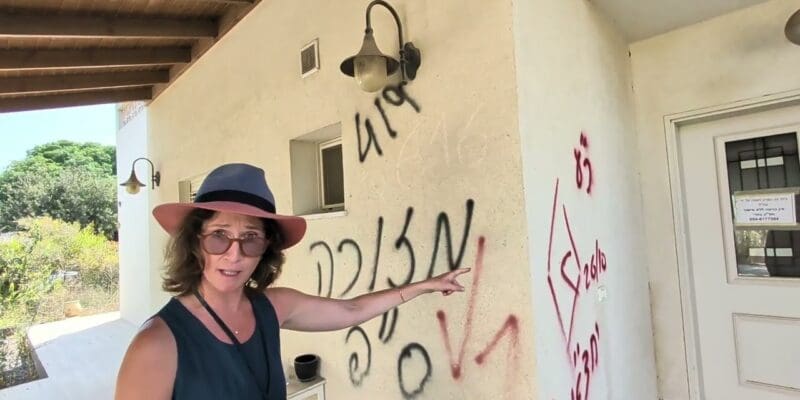Walking through the Be’eri Kibbutz in the Gaza Envelope, the name for the area surrounding the strip itself, one not only sees the scars of the October 7th all-out assault by Hamas two years ago but also hear the bitter harvest of the Palestinian militants’ attack.
Being within a perimeter zone no more than four miles from the Gaza border, the thunderous boom of artillery reverberates across the battered community.
Though having visited countless historic battlefields from Gettysburg to Omaha Beach the sounds that resembled noise from a construction site brought forth a sudden realization: for the first time in my life I was actually within earshot of war.
Behind me was an earthen berm that one would normally associate with flood protection but seemed out of place in an arid environment but was there as a barrier to separate the residential community from projectiles blasted in the vicinity.
The ruined family structures in front of me also served as a reminder that I was standing well within range of mortars and Qassam rockets fired from Gaza, the border being a 90 minute walk west.
Trudging across the rubble of a home that was close to the aforementioned land wall, was like something from Prypiat, the wrecked abandoned Ukrainian town near Chernobyl. The roof had been torn up from Hamas’ barrage that signaled their offensive.
But as terrible as the rocket and mortar shell damage, I would come across a more disturbing visual upon entering the house.
Being within proximity of short-range attacks from within Gaza, many houses in the region have safe rooms where people can retreat to safety once the air raid siren is activated.
Hamas, whose agents had meticulously studied their targets far in advance of the October 7th attack, knew about the air raid siren protocols and were counting on their victims going to their safe rooms shortly after the incoming alerts.
Seeking to gain some degree of leverage after their attack was inevitably fended off, Hamas wanted hostages and they knew precisely where to look for them: the safe rooms that became holding cells and in some instances slaughter pens.
The safe rooms were designed to provide a degree of protection from bombardment but not ground attack.
And once the Hamas terrorists entered this home in particular they attempted to break through the door that was being manually held shut by the family’s patriarch. The militants then shot through the door handle to get inside to reach their prey.
In other houses Hamas simply tossed hand grenades into the safe rooms to kill the occupants even though they were unarmed and not a threat.
While walking the neighborhood my eyes caught something eerily familiar; spray paint markings on the exteriors of the houses.
Shortly after Katrina large Xs were painted on structures to indicate that they had been inspected by the National Guard or other civil servants along with numbers and letters that identified the date they were checked and by which unit.
The bottom quadrant was generally reserved for the number of bodies found in the house during the inspection.
The Israelis used a similar system though in Hebrew. However their code for the discovery of bodies was a dot within a circle. Due to Hamas’ reputation for setting up booby traps by utilizing the corpses of their victims, separate units handled body discovery and recovery.
In the relatively small kibbutz of Be’eri, 101 residents were murdered and 35 were kidnapped.
A few miles southwest is the site of the worst Hamas massacre on October 7th- the Nova Music Festival.
At 7 AM utilizing trucks, motorcycles, and paragliders, Hamas forces heading in the direction of a city came upon a target of opportunity- a giant rave party attended by over 3000 people being held between Jewish holidays.
The terrorists went on a murder and rape spree killing 344 civilians and abducting another 40 partygoers. Bodies discovered at the site showed evidence of sexual mutilation.
Today the blood soaked grounds contain memorials to the Hamas victims featuring their pictures, names, and biographies along with artistic murals and displays, including a dj booth display and a large field of red anemone ceramic sculptures arranged in a Star of David.
But more moving than the tributes are the presence of visitors, some in IDF uniform, paying respect to their countrymen, friends, and family.
Israel is both in terms of geography and population a small place and for a nation of 10 million people, the deaths of 344 civilians and 34 security personnel in one relatively small area directly touched through relationships and connections a disproportionate share of the country. The sense of pain and loss is personal.
The Nova Music Festival massacre is Israel’s Twin Towers attack.
That the depredations committed were conducted by individuals on other individuals adds to the cruelty exponentially. The murderers looked many of their victims in the eyes as they butchered and sexually assaulted them.
How holy and righteous can the cause of Hamas really be through raping women to death and slaughtering screaming kids? Yet their apologists are legion, ironically in the centers of America’s higher education.
My last two days in Israel there were rocket attacks courtesy of the Houthis operating in Yemen.
Upon arriving at the airport the air raid siren cut loose and people abandoned their luggage in line and scrambled to the bomb shelters at Ben-Gurion Airport in Yafo. The sound was unsettling but I didn’t rush off and continued to trundle by own suitcases down the sidewalk to the utter chagrin of the folks who were with me.
It wasn’t an act of courage or defiance; I wanted in my last moments in Israel to truly experience what the people of Israel live with day in and day out and I recorded the wailing alarm. This can’t be compared to a fire alarm, a sound that is generated from within a building but from strategically located load speakers across the country. I’ve never heard anything like it before in my life.
Once the alarm ceased people returned to their respective airline check in corrals; normalcy in an abnormal time. Three rockets had been launched: one was intercepted, one was a dud, but the third hit a hotel in Eilat- blocks away from a place I stayed ten years ago.
Two days before there had been another Houthi launch but that was knocked out before the air raid siren was initiated. That said I was told to expect to hear it. Reassured by the news I walked down to the beach in Tel Aviv to await the alarm that didn’t come that particular day and serenely watched the waves of the Mediterranean roll on to the sand, much like the first Jewish settlers had on the same shoreline in the late 19th century.
Two female soldiers in their IDF uniforms were enjoying the good weather and were playfully pushing each other on a large swing set.
The pair were finding a moment of joy while serving their country in a time of strife. It was a reminder of the duality every Israeli must learn to live with- waging a battle for existence while simultaneously seizing that which makes life worth living.
Advertisement
Advertisement

